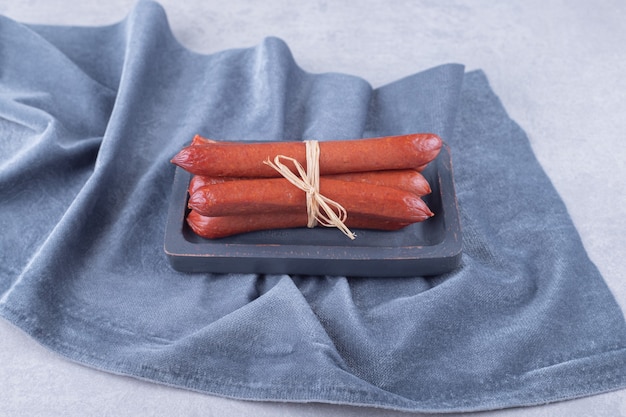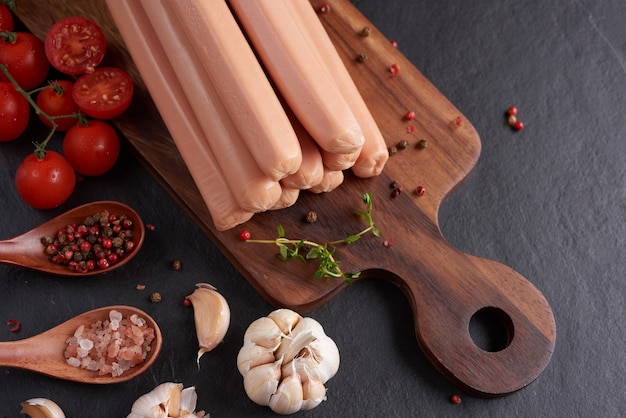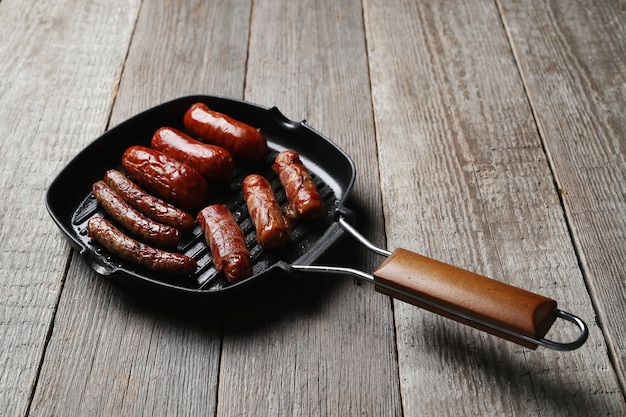(Part 1) The Great Chorizo Divide: Spanish vs. Portuguese

Spanish Chorizo: The Smoky Star
Spanish chorizo is known for its smoky, paprika-heavy flavour. It's typically cured and comes in a couple of main forms: Chorizo Cular: The traditional, whole sausage, cured in a casing. It's often enjoyed sliced and grilled, or cooked whole and served as part of a tapas platter. Chorizo Picante: A crumbled, semi-cured variety that's ready to cook. This is the kind you'll most commonly find in supermarkets, perfect for adding to dishes like paella, or cooking in a pan to serve with eggs or vegetables.portuguese chorizo: A More Subtle Flavour
Portuguese chorizo, on the other hand, tends to be milder, with less paprika and a more garlic-forward flavour. It's usually smoked, too, and also comes in whole and crumbled forms. It's often used in stews, soups, and even as a filling for pastries.(Part 2) Navigating the World of Chorizo Styles

1. Sweet Chorizo: A Touch of Honey
Now, this one might surprise you. Sweet chorizo, especially popular in some parts of Spain, has a hint of sweetness from added sugar or honey. It's a little less spicy and often used in dishes like paella or as a topping for bread. Think of it as a delicious, slightly spicy, and sweet addition to your meal.2. Chorizo with Other Flavours: Pushing the Boundaries
We've got chorizo with herbs, chorizo with chilli, chorizo with fennel seeds, and even chorizo with orange zest. The possibilities are endless, and I’ve even stumbled upon a chorizo with a touch of cinnamon. It’s a delicious and unexpected twist, a perfect example of how chorizo can be so versatile. The addition of these other flavours creates unique and exciting taste experiences, perfect for adventurous cooks and food lovers.(Part 3) The Big Question: How Long Do I Cook It?

General Guidelines for Cooking Time
Here's a rough guide to help you out: Cured chorizo: A few minutes on each side over medium heat is usually enough. You'll know it's cooked when it’s slightly browned and the fat has rendered out. The fat will become clear and the sausage will be firm to the touch. Fresh chorizo: Cook for about 10-15 minutes, breaking it up into smaller pieces. It should be cooked through and no longer pink. You can also use a meat thermometer to ensure it reaches an internal temperature of 160°F (71°C).(Part 4) The Art of Frying Chorizo: Getting It Just Right
Okay, let's talk about frying chorizo, a classic method that's perfect for a quick and easy meal.1. The Pan: Choosing the Right One
Start with a good quality pan, ideally cast iron or stainless steel, that’s large enough to hold the chorizo without overcrowding. Crowding the pan will result in steaming rather than frying, and nobody wants that. A cast iron pan heats evenly and retains heat well, which is ideal for frying chorizo.2. Heat Matters: Medium to Medium-High
You want the pan hot, but not scorching. Medium to medium-high heat is perfect. If it’s too hot, the chorizo will burn before it has a chance to cook through. A good test is to see if a drop of water sizzles immediately when it hits the pan.3. Don't Overcrowd: Give It Room
As I mentioned, overcrowding is a no-no. Let the chorizo sizzle happily, giving each piece enough space to brown evenly. This allows the fat to render out properly and prevents the chorizo from steaming.4. Don't Forget the Fat: The Delicious Magic
As the chorizo cooks, it will release a ton of delicious fat. This fat is packed with flavour, so don’t drain it all off! You can use it to cook vegetables, eggs, or even make a delicious chorizo sauce. This fat is a flavour bomb waiting to be unleashed!(Part 5) Grilling Chorizo: A Smokey Delight
Let's bring those BBQ skills to the table! Grilling chorizo adds a lovely smoky flavour and a delightful char.1. Preheat Your Grill: Heat It Up
Just like with the pan, preheat your grill to medium-high heat. This will ensure that the chorizo cooks quickly and evenly. A hot grill is essential for achieving those beautiful grill marks.2. Let It Sizzle: Direct Heat is Your Friend
Place the chorizo directly over the heat, letting it sizzle and brown. It's a beautiful sight to see! The direct heat allows the chorizo to cook quickly and develop a nice char.3. Flip It, Grill It: A Little Patience
Flip the chorizo every few minutes to ensure even cooking. It's a simple process, but keep an eye on it to prevent burning. It takes a little patience to achieve perfectly grilled chorizo.4. The Finished Product: Juicy and Smokey
When the chorizo is cooked through and has a nice char, you’re good to go. Enjoy the smoky, juicy flavour that’s perfect for a summer BBQ. It's like a party in your mouth!(Part 6) Baking Chorizo: Easy and Versatile
Let’s be honest, sometimes you just want to pop something in the oven and let it bake. Baking chorizo is incredibly easy and versatile.1. The Oven: Get It Up to Temperature
Preheat your oven to 400°F (200°C). You want that oven nice and toasty for a perfect bake. A preheated oven ensures even cooking and browning.2. The Pan: Choosing the Right One
A baking sheet or a shallow roasting pan works perfectly. Don’t forget to line it with parchment paper to make cleanup a breeze. Parchment paper prevents sticking and makes cleanup a breeze.3. Spread It Out: Give It Space
Spread the chorizo out in a single layer on the baking sheet, leaving a little space between each piece. This will allow for even cooking and browning. This ensures that each piece of chorizo gets enough heat and cooks evenly.4. The Bake Time: Keep an Eye on It
Bake the chorizo for about 15-20 minutes, or until cooked through and nicely browned. Every oven is different, so keep an eye on it. It's best to check the chorizo after 10 minutes to ensure it's not burning.(Part 7) Beyond Cooking Time: Tips and Tricks
Alright, so now you know how long to cook chorizo, but there are a few more things you should know to take your chorizo game to the next level:1. Adding Flavor: Spiced Up
Don't be afraid to get creative with spices! Add a sprinkle of smoked paprika, cumin, or cayenne pepper to your chorizo for an extra kick. These spices complement the smoky flavour of chorizo and add depth and complexity.2. The Fat: Don't Waste It
As I mentioned earlier, the fat that renders out of chorizo is full of flavour. Don't throw it away! You can use it to cook vegetables, eggs, or even make a delicious sauce. This fat is a gold mine of flavour.3. Storage: Keep It Fresh
Store cured chorizo in the fridge for up to a week or freeze it for up to a month. If you're using fresh chorizo, store it in the fridge for a couple of days. Proper storage ensures that your chorizo stays fresh and delicious.4. The Leftovers: A New Life
Don't throw away leftover chorizo! You can use it in pasta dishes, salads, or even as a topping for pizzas. It's a great way to add flavour and protein to your meals.(Part 8) FAQs: The Frequently Asked Chorizo Questions
1. What is the difference between Spanish and Portuguese chorizo?
Spanish chorizo is known for its smoky, paprika-heavy flavour, while Portuguese chorizo is milder, with less paprika and a more garlic-forward flavour. They also have different consistencies, with Spanish chorizo being firmer and Portuguese chorizo being softer.
2. Can I eat chorizo raw?
It's generally not recommended to eat chorizo raw, as it can contain harmful bacteria. While cured chorizo is typically safe to eat without cooking, it's still best to cook it for a few minutes to kill any lingering bacteria and bring out the flavour.
3. What are some good ways to use chorizo in dishes?
Chorizo is incredibly versatile! You can add it to pasta dishes, stir-fries, salads, soups, and stews. It's also great as a filling for empanadas, tacos, or sandwiches. Try it crumbled on top of pizzas or even used as a topping for baked potatoes.
4. How do I tell if chorizo is cooked?
Cured chorizo should be slightly browned and the fat should have rendered out. Fresh chorizo should be cooked through and no longer pink. If you're unsure, use a meat thermometer to ensure the internal temperature reaches at least 160°F (71°C).
5. How do I make chorizo sauce?
Chorizo sauce is easy! Just cook chorizo in a pan until it's browned and the fat has rendered out. Then, add onions, garlic, and your favourite spices. Simmer for a few minutes until the sauce thickens, and you're done!
(Part 9) A Final Bite: Embrace the Chorizo Journey
There you have it, your complete guide to chorizo cooking time! Remember, the key is to experiment and have fun. Try different cooking methods, add your own spices, and discover your own favourite chorizo combinations. So go forth, my fellow chorizo enthusiasts, and unleash the deliciousness!Everyone is watching

Perfect Rice Every Time: The Ultimate Guide to Cooking Rice
Cooking TipsAs a self-proclaimed foodie, I've always been a bit obsessed with rice. It's the foundation of countless cuisi...

Prime Rib Roast Cooking Time Chart: Per Pound Guide
Cooking TipsPrime rib roast. Just the name conjures images of lavish dinners, crackling fires, and hearty laughter. It’s ...

The Ultimate Guide to Cooking Asparagus: Tips, Techniques, and Recipes
Cooking TipsAsparagus. The mere mention of this spring delicacy conjures up images of vibrant green spears, crisp and burs...

Ultimate Guide to Cooking the Perfect Thanksgiving Turkey
Cooking TipsThanksgiving. Just the word conjures up images of overflowing tables laden with delicious food, the scent of r...

How Long to Bake Potatoes in the Oven (Perfect Every Time)
Cooking TipsBaked potatoes are a staple in my kitchen. They're incredibly versatile, delicious, and surprisingly easy to m...
